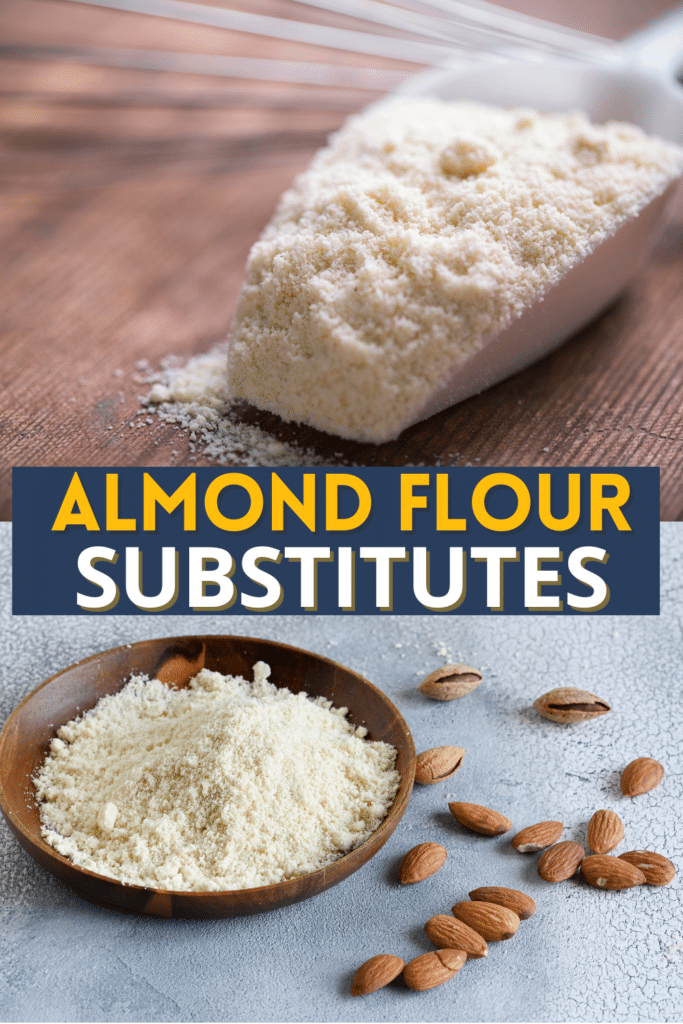Almond Flour Substitutes: Delicious and Healthy Alternatives
Have you ever found yourself searching for almond flour substitutes? Maybe you were following a recipe and realized you had to find a different one because you cannot use almond flour. Well, this has been the story of my life over the last 15 years. When my oldest daughter was 5, we found out she had a nut allergy. When I say nut allergy, I mean the kind that is off the charts for all but one type of nut.

Want to save this recipe?
Whether you’re like my daughter and have a nut allergy, need to try something different, or don’t have any almond flour on hand, there are plenty of alternative flours that can be used in its place. Let’s take a look at some of the best almond flour substitutes for baking and cooking.
Almond flour is a popular ingredient in gluten-free and low-carb baking. The flour is made from blanched almonds that have been ground (with a blender or food processor if you’re making it yourself) into a fine flour. This flour is high in protein, healthy fats, and fiber, making it a nutritious choice for baking. On the downside, it can be expensive and may not be available at stores in your area. That’s where almond flour substitutes come in handy. Finding good almond flour alternatives allows you to enjoy your favorite recipes without compromising taste, texture, or nutritional value.
Understanding Almond Flour
Almond flour is a super popular ingredient in gluten-free, grain-free, and low-carb recipes. It is made from ground almonds and has a fine texture similar to wheat or white flour. It’s a little different from almond meal as it is more fine and processed differently. Almond flour is used in a variety of recipes, from cakes and cookies to bread and pancakes. Because of my daughter’s nut allergy, I do not have any almond flour recipes on my site.
Nutritional Profile
Almond flour is an ingredient filled with nutrients and is rich in protein, healthy fats, and fiber. The carb count is low, and it is gluten-free, making it an excellent option for people with celiac disease or gluten intolerance. According to Medical News Today, two tablespoons of almond flour contains:
Calories: 79.9
Protein: 3 g
Fat: 7 g
Carbohydrates: 3 g
Dietary fiber: 2 g
Magnesium: 10% of the recommended daily intake (RDA)
Vitamin E: 25% RDA
Saturated fatty acids: 3% RDA
Common Uses
As mentioned, almond flour is used in gluten-free, grain-free, and low-carb baking. It can also be used as a coating, like breadcrumbs, for chicken, fish or veggies and as a thickener for soups and sauces.
Baking Characteristics
This type of flour has very different baking characteristics than wheat flour. It is denser and heavier than other flours. Almond flour also has a bit of a nutty flavor, which can add a unique flavor to baked goods. It’s important to adjust the recipe accordingly to ensure the best results when using almond flour.
Almond Flour Alternatives
Several options can work if you are looking for substitutes for almond flour. Here are some almond flour alternatives that you can use in your baking recipes:
Coconut Flour
Coconut flour is an excellent alternative to almond flour. This is my go to especially since my daughter is allergic to nuts and my husband and I stick to low-carb diets. It is high in fiber, low in carbohydrates, and has a slightly sweet taste.
It is important to note that coconut flour absorbs more liquid than almond flour. So, you may need to adjust the amount of liquid or flour in your recipe. I have gotten so many comments on kaseytrenum.com from people that substituted coconut for almond flour but used it at a 1:1 ratio. Dry, dry, dry…
- Ratio: Use 1/4 cup to 1/3 cup of coconut flour for every 1 cup of almond flour.
- Adjustment: Increase the number of eggs in the recipe (usually double) to help bind the ingredients and add moisture.
- Tip: Gradually add liquid ingredients until you reach the desired consistency, as coconut flour is highly absorbent.
All-Purpose Flour
All-purpose flour is a common substitute for almond flour. This is in almost everyone’s cabinet! However, it’s not gluten-free or low-carb, so it may not be a good option for everyone. If you are using all-purpose flour as a substitute, remember that it has a different texture and taste than almond flour, so your recipe may turn out differently. This is an excellent option for breads, cakes, and pie crusts.
- Ratio: Use 1 cup of all-purpose flour for every 1 cup of almond flour.
- Adjustment: Reduce the amount of fat (butter or oil) in the recipe by about 25% to account for the lower fat content in all-purpose flour compared to almond flour.
- Tip: If the batter or dough seems too dry, add liquid ingredients (like milk or water) 1 tablespoon at a time until you reach the desired consistency.
Rice Flour
Rice flour is another gluten-free alternative to almond flour, but it is not low-carb. Its gritty texture and mild taste make it a good substitute for almond flour in recipes like cakes and cookies. Like coconut flour, it absorbs more liquid than almond flour, so you may need to adjust the amount of liquid or flour in your recipe.
- Ratio: Use 7/8 cup of rice flour for every 1 cup of almond flour.
- Adjustment: Add an extra egg or a binding agent (like xanthan gum) to help hold the ingredients together, as rice flour can be crumbly.
- Tip: For a smoother texture, use fine-milled rice flour or blend the flour in a food processor before using it in recipes.
Cassava Flour
Cassava flour is a grain-free and gluten-free flour that is made from the cassava root. It has a mild taste and a texture similar to wheat flour. This flour is a good substitute for almond flour in recipes such as bread, muffins, and pizza crusts. One thing to know is that cassava flour is high in carbohydrates, so it may not suit those on a keto diet.
- Ratio: Use 3/4 cup of cassava flour for every 1 cup of almond flour.
- Adjustment: Reduce the amount of liquid ingredients slightly, as cassava flour is less absorbent than almond flour.
- Tip: If the batter or dough seems too wet, add cassava flour 1 tablespoon at a time until you reach the desired consistency.
Nut-Free Substitutes for Almond Flour
If you have a nut allergy or want to switch things up, there are several good alternatives for almond flour. Here are a couple of options:
Sunflower Seed Flour
Sunflower seed flour is a great swap for almond flour. It’s made from ground sunflower seeds and has a coarser texture and nutty flavor similar to almond flour. This flour is high in protein and healthy fats, making it a nutritious choice.
Keep in mind that the latter may turn your baked goods a slightly green color—weird—but it won’t affect the flavor.
- Ratio: Use a 1:1 ratio when substituting sunflower seed flour for almond flour.
- Adjustment: If the recipe calls for baking powder or baking soda, add a pinch of lemon juice or apple cider vinegar to balance out any potential green color that may develop due to the reaction between the seeds and the leavening agents.
- Tip: Sunflower seed flour can be dense, so consider adding an extra egg or a bit more liquid to lighter recipes like cakes or muffins.
Pumpkin Seed Flour
Pumpkin seed flour, similar to pumpkin seed meal, is a good option if you want a nut-free alternative to almond flour. It is made from ground pumpkin seeds and has a mild, nutty flavor and a slightly green color. Again…totally weird.
- Ratio: Use a 1:1 ratio when substituting pumpkin seed flour for almond flour.
- Adjustment: Pumpkin seed flour has a slightly green color, which may affect the appearance of your baked goods. If this is a concern, consider adding a touch of cocoa powder or other natural food coloring to mask the green hue.
- Tip: Like sunflower seed flour, pumpkin seed flour can be dense, so consider adding an extra egg or a bit more liquid to lighter recipes.
Grain-Free Almond Flour Replacements
I’ve got some options for you if you want grain-free alternatives to almond flour. These substitutes are great for people on a gluten-free or paleo diet or who want to avoid grains.
Arrowroot Powder
Arrowroot powder is a starchy substance extracted from the roots of the arrowroot plant. It is a great substitute for almond flour because it is gluten-free and grain-free. Arrowroot powder works well in baked goods such as cakes, cookies, and bread.
- Ratio: Use a 1:1 ratio when substituting arrowroot powder for almond flour.
- Adjustment: Arrowroot powder is often used as a thickener, so you may need to reduce the amount of other thickening agents (like xanthan gum) in the recipe.
- Tip: Arrowroot powder can make baked goods slightly crispier, so it’s a good choice for recipes like cookies or crackers.
Tapioca Flour
Tapioca flour is another grain-free substitute for almond flour. It’s made from starch extracted from cassava roots. Tapioca flour is gluten-free, grain-free, and low in calories, making it a good option for people who are looking to lose weight.
- Ratio: Use a 1:1 ratio when substituting tapioca flour for almond flour.
- Adjustment: Tapioca flour can make baked goods chewier, so it’s a good choice for recipes like bread or pizza crust. However, for lighter recipes like cakes or muffins, consider reducing the amount of tapioca flour slightly or adding an extra egg for better structure.
- Tip: Tapioca flour can sometimes form clumps, so be sure to sift it before incorporating it into your recipe.
How to Choose the Right Substitute for Almond Flour
There are a few things to consider when choosing a substitute. You want to make sure that the substitute will not only work well in your recipe but also taste good. Here are some things to keep in mind when choosing a substitute:
Taste Considerations
One of the most important things to consider when choosing a substitute for almond flour is the taste. Almond flour has a slightly nutty and sweet flavor so you want to choose a substitute that will complement your recipe. For example, if you’re making a dessert, you might want to use a substitute that has a slightly sweet flavor, like coconut flour. On the other hand, if you’re making a savory dish, you might want to use a substitute with a more neutral flavor, like sunflower seed flour.
Texture Considerations
Another important thing when choosing a substitute is the texture. Almond flour has a fine, powdery texture, so you want to choose a substitute with a similar texture. For example, coconut flour is a good substitute because it has a similar consistency. However, if you’re using a substitute like rice flour, you might need to adjust the amount of liquid in your recipe to get the right texture.
Recipe Adaptations
Finally, when choosing a substitute, you need to consider how it will affect your recipe. Some substitutes will work well in any recipe and some…not so much. For example, if you’re using a substitute like coconut flour, you may need to use more eggs, other binding agents, or less flour to keep your recipe from falling apart. On the other hand, if you’re using a substitute like sunflower seed flour, you may need to reduce the amount of liquid in your recipe to prevent it from becoming too dense.
Final Thoughts on Almond Flour Substitutes
Wow, we’ve covered a lot of ground in this post! From understanding the unique properties of almond flour to discovering a wide range of substitutes, I hope you’re feeling more confident and inspired to experiment with different flours in your own cooking and baking.
As someone who’s been navigating the crazy world of nut allergies and special diets for years, I know how challenging it can be to find the right substitutes for your favorite recipes. But with a little knowledge and a willingness to try new things, you’d be surprised at how delicious and satisfying your creations can be!
My personal favorite almond flour substitute is coconut flour. It’s been a lifesaver for my family. It has allowed us to enjoy low-carb and nut-free treats that everyone loves.
So, whether you’re dealing with allergies, following a special diet, or simply looking to mix things up in the kitchen, give almond flour substitutes a try. Start with one of the options we’ve discussed here, and don’t be afraid to experiment until you find the perfect one.
Trust me, with a little patience and perseverance, you’ll be whipping up simple, delicious, wholesome treats that everyone will enjoy – no almond flour required!
Frequently Asked Questions
What can I use in place of almond flour for keto-friendly recipes?
If you’re looking for a keto-friendly replacement for almond flour, try using coconut flour. Coconut flour is low in carbs and high in fiber, making it an excellent option for those following a keto diet. Just remember that coconut flour is more absorbent than almond flour. You may need to adjust the amount of liquid or reduce the flour in your recipe. Another option is hazelnut flour, which has a similar texture and flavor to almond flour.
How do I substitute regular flour for almond flour in baking?
Almond flour is much more dense and moist than regular flour. A good rule of thumb is to use 1 cup of almond flour for every 1/4 cup of regular flour. You may also need to adjust the amount of liquid or flour in your recipe, as almond flour absorbs more liquid than regular flour.
What’s the best almond flour substitute for baking?
Cashew flour has a similar texture and flavor to almond flour, making it a great substitute. You can also use hazelnut or sunflower seed flour for a slightly different flavor profile.
Is there a standard substitution ratio when replacing almond flour with other flour?
There is no standard substitution ratio when replacing almond flour with other flour since flour has unique properties. Most nut flours use a 1:1 ratio. For coconut flour, you may need to use less and adjust the amount of moisture in your recipe.
Can oat flour be used as a substitute for almond flour in my recipes?
Yes, many recipes can use oat flour as a substitute for almond flour. Oat flour has a similar texture and is a great option for those with nut allergies. However, keep in mind that oat flour has a slightly different flavor than almond flour so that it may affect the taste of your recipe.
What are some nut-free flour options for people with almond allergies?
There are several nut-free flour options you can use as a substitute. Some popular choices include coconut flour, cassava flour, and tapioca flour. You can also use oat or rice flour for a slightly different flavor profile.
Can I use almond meal instead of almond flour?
Although almond meal and almond flour are both made by grinding almonds, they’re very different. Almond meal is made with almonds that still have their skins on, so it’s a bit coarser and almond flour uses blanched almonds without the skins. This results in a finer, more delicate texture. So, if you’re recipe calls for almond flour, it’s best to stick with that.
Can I use almond flour substitutes for breading or coating?
of course. Many almond flour substitutes can be used for breading or coating foods. Coconut flour, sunflower seed flour, and pumpkin seed flour are all good options for creating a crispy, flavorful coating on meats or veggies. Keep in mind that the flavor and texture may vary depending on the substitute you choose.





